As a passive investor that’s interested in multifamily deals, you might be wondering why syndicators LOVE to refinance.
Today, we are going to answer these common questions about refinancing multifamily syndications:
How does a refinance work?
Under what circumstances do we refinance?
What’s the benefit of refinancing a multifamily deal?
One thing’s for sure; we don’t make money moves without looking closely at our numbers. In this video, I’ll share with you the exact calculator that I use to determine when the time’s right to refinance.
Join us in the video below, where you can see the income calculator in action.
Refinancing a Value-Add Deal
If you’ve followed me for a while now, you know that my favorite investment strategy is the value-add deal.
Simply put, we buy a property and renovate it to add value to the tenants, raise rents, and increase the Net Operating Income (NOI) and overall valuation of the property.
So, let me show you an example. You’ll need to watch along with the video to see these numbers adjust in the calculator.
We recently did a 275 unit deal in Huntsville, Alabama for $18 million. When we bought the property, the NOI was about $1 million per year.
Related Video: A Multifamily Property Tour in Alabama
After a $4 million renovation, we were able to raise rents and increase the NOI to $1.5 million.
The valuation now shows a cap rate of 6%, and the property is worth $25 million.
We are in the deal for roughly $22 million total, including renovations, and we’ve created about $3 million of value.
At this point, the calculator shows that we have achieved our targets rents and the property has stabilized. The value-add efforts have essentially stopped.
So, what can we do to keep the ROI increasing for our investors? Refinance!
With a refinance, we repay the old loan and return a part of the capital to the investors. In this particular example, we returned 51% of the investors’ capital. If the NOI were a little higher, say $1.7 million, the percentage would increase to 89%.
Investors love this strategy too because they have less money wrapped up in this one deal, and are able to diversify. Whether that means putting this money to work in another multifamily deal, or in a different asset altogether, they can increase their ROI while continuing to receive distributions on this deal.
Related Article: Alternative Assets to Compliment a Multifamily Portfolio
What’s not to love?
Reinvesting after a Refinance
Let’s turn our attention back to the Passive Investor Income Calculator to see how an investor that uses their return to reinvesting in multifamily syndications is impacted over time.
Again, you’ll want to refer to the video accompanying this blog to see the numbers change in the calculator as we roll through these numbers.
In this example we’re going to make a few assumptions:
- You’re investing $50,000 per year, passively, in multifamily syndications.
- Each property refinances after 2 years.
- You get an average of 50% of your capital back after each refinance.
This is a good model here, but if you look, you can see quickly in year 5 that your cash-on-cash return goes from 7% to 9% in the first several years.
Once we start refinancing and you get that money back and you reinvest it, you're getting a double return. So starting in year 5, your cash-on-cash return creeps up to 20%, 25%, and 30%!
That is the amazing compounding effect of reinvesting in multifamily, and value-add multifamily specifically. It’s why so many of our investors are repeat customers.
Knowing When to Hold and Fold
At Nighthawk, about 50% of our deals are long-term deals. We shoot to get 70% or more of our investors’ capital back after a refinance, and many choose to reinvest it with us.
But not every property refinances. Sometimes we sell the property outright.
The decision to hold or fold really depends on the numbers and the market. Do we like the market? Do we like the longevity market? Do we like the deal itself?
For example, right now we're exiting some of our earlier deals, which are some of our smaller deals. We think they're a little bit riskier than the larger ones, which we also find to be more interesting.
The larger deals are much better suited for a 10+ year hold and for a refinance, so that’s where we are keeping our attention these days.
If you’d like to talk with us about what we’ve got brewing at Nighthawk, head over to our website: www.NightHawkEquity.com. Click the “Join” button to schedule a phone call with our deal desk.
Predicting YOUR Profits & Cash Flow
If you want to put a plan in motion to become financially free, I invite you to download the spreadsheet that you see me use in the video.
We call it the Passive Investor Income Calculator, and you can get it by clicking on the button below.
The cool thing about this calculator is that you can change the fields to reflect the $$ that YOU are comfortable investing, and better yet, use it to project your realized profits and cash flow!
Related Video: How to Project Your Passive Investment Income
Take some time to download the calculator and play around with it. Be prepared to get excited, as you can very quickly see the impact to your net worth.
And if you haven’t already, check out these additional resources I’ve created just for you in the Apartment Building Investing Learning Center.
Thanks for being here, and we’ll see you in the next video!
